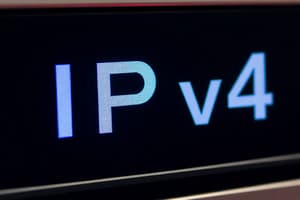Podcast
Questions and Answers
What role does the subnet mask serve in identifying portions of an IPv4 address?
What role does the subnet mask serve in identifying portions of an IPv4 address?
- It translates domain names to IPv4 addresses.
- It provides the actual network and host addresses.
- It assigns unique IPv4 addresses to devices.
- It differentiates between the network and host portions of the IPv4 address. (correct)
Why is the network portion of an IPv4 address identical for all devices in the same network?
Why is the network portion of an IPv4 address identical for all devices in the same network?
- To identify the specific host within the network.
- To ensure efficient routing and addressing. (correct)
- To allow for global communication.
- To facilitate subnetting of different networks.
What is a key characteristic of a host address?
What is a key characteristic of a host address?
- Should be unique within its network. (correct)
- Must have all bits in the host portion set to 1.
- Can be all zeros in the host portion.
- Can be identical to the network address.
What additional IPv4 address is needed to connect to remote networks apart from the host's address?
What additional IPv4 address is needed to connect to remote networks apart from the host's address?
In what scenario would a broadcast address be used?
In what scenario would a broadcast address be used?
What prefix length corresponds to the subnet mask 255.255.255.0?
What prefix length corresponds to the subnet mask 255.255.255.0?
What is the purpose of a directed broadcast in a network?
What is the purpose of a directed broadcast in a network?
Which of the following statements is true about private IPv4 addresses?
Which of the following statements is true about private IPv4 addresses?
What is the effect of excessive broadcast traffic on network performance?
What is the effect of excessive broadcast traffic on network performance?
In which range are IPv4 multicast addresses reserved?
In which range are IPv4 multicast addresses reserved?
What is the primary use of loopback addresses?
What is the primary use of loopback addresses?
Which class of IPv4 addressing is designed for extremely large networks?
Which class of IPv4 addressing is designed for extremely large networks?
What happens to broadcasts when received by a router?
What happens to broadcasts when received by a router?
What type of addresses do Windows DHCP clients use when there are no DHCP servers available?
What type of addresses do Windows DHCP clients use when there are no DHCP servers available?
Why is it beneficial to create smaller broadcast domains through subnetting?
Why is it beneficial to create smaller broadcast domains through subnetting?
What is one significant advantage of subnetting a network?
What is one significant advantage of subnetting a network?
When subnetting on an octet boundary, what happens when more bits are borrowed from the host portion of an address?
When subnetting on an octet boundary, what happens when more bits are borrowed from the host portion of an address?
What is one of the most common subnetting practices for organizations requiring a reasonable number of hosts?
What is one of the most common subnetting practices for organizations requiring a reasonable number of hosts?
Flashcards are hidden until you start studying
Study Notes
IPv4 Address Structure
- IPv4 address consists of 32 bits divided into a network portion and a host portion.
- Network portion is the same for all devices in the same network; host portion must be unique to identify individual devices.
- Subnet mask helps determine the division between the network and host portions.
Subnet Mask
- Defines which part of an IPv4 address is the network address and which part is the host address.
- A default gateway is needed for accessing remote networks; DNS server addresses convert domain names to IPv4.
- Subnet mask is presented in both dotted decimal and binary formats and does not contain network/host data itself.
Prefix Length
- Prefix length represents the number of bits set to 1 in the subnet mask and is denoted in slash notation (e.g., /24).
- Common prefix length example is 192.168.10.10 with a subnet mask of 255.255.255.0 written as 192.168.10.10/24.
Logical AND Operation
- Logical AND is a Boolean operation used to find the network address by comparing individual bits.
- Only 1 AND 1 results in 1; all other combinations yield 0.
- For instance, AND operation on 192.168.10.10 and subnet mask 255.255.255.0 results in a network address of 192.168.10.0.
Types of IP Addresses in a Network
- Three main types: Network address, Host addresses, and Broadcast address.
- Network address represents the whole network and cannot be assigned to devices. It contains all 0s in the host portion (e.g., 192.168.10.0).
- Host addresses can be assigned to devices but must be unique. First host starts at 192.168.10.1, and the last host is at 192.168.10.254.
- Broadcast address is used to reach all devices in the network with all 1s in the host portion (e.g., 192.168.10.255).
Transmission Methods
- Unicast: One-to-one communication, a device sends data to a specific device.
- Broadcast: One-to-all communication, data sent to all devices in the network.
- Directed broadcast: sent to everyone in a specific network (e.g., 172.16.4.255).
- Limited broadcast: sent to all devices within the broadcast domain (e.g., 255.255.255.255).
- Multicast: One-to-selected group communication where packets are sent to specific subscribed hosts (e.g., OSPF protocols use 224.0.0.5).
Public and Private IPv4 Addresses
- Public IPv4 addresses are routable on the internet and must be unique.
- Private IPv4 addresses (defined in RFC 1918) are used internally within an organization and cannot be routed on the internet.
Network Address Translation (NAT)
- NAT translates private addresses to public addresses before packets are sent to the internet, typically performed by routers connecting internal networks to ISPs.
Special IPv4 Addresses
- Loopback Addresses (127.0.0.0/8): Used for testing internal TCP/IP configurations, primarily 127.0.0.1.
- Link-Local Addresses (169.254.0.0/16): Self-assigned IP addresses used when DHCP servers are unavailable.
Legacy Classful Addressing
- IPv4 addresses were originally categorized into classes (A, B, C) based on size:
- Class A: Supports over 16 million hosts, prefix /8.
- Class B: Up to 65,000 hosts, prefix /16.
- Class C: Maximum of 254 hosts, prefix /24.
Broadcast Domains and Network Segmentation
- Broadcast domains are segments of a network where broadcasts are transmitted.
- Routers separate broadcast domains and do not propagate broadcasts, helping to control and limit unnecessary traffic.
- Too many hosts in a large broadcast domain can create excessive broadcast traffic, affecting network performance.### Network Traffic and Subnetting
- Slow network operations arise from excessive broadcast traffic, impacting device performance as each packet must be processed.
- Subnetting creates smaller broadcast domains, reducing overall traffic and enhancing performance by segmenting a network.
- For example, a network with 400 users at address 172.16.0.0 /16 can be divided into two subnets: 172.16.0.0 /24 and 172.16.1.0 /24.
- Broadcasts are contained within subnets, preventing propagation to other segments.
Benefits of Subnetting
- Enhances network performance and allows for targeted security policies regarding inter-subnet communication.
- Limits the impact of abnormal traffic caused by misconfigurations or malicious activity.
- Network administrators can create customized subnets based on network requirements and manage devices more effectively.
Subnetting Basics
- Subnets are achieved by borrowing host bits, increasing network bits to create additional segments while reducing the number of hosts per subnet.
- Segmenting at octet boundaries such as /8, /16, and /24 is common and simplifies subnetting.
- For instance, a private address like 10.0.0.0/8 connects over 16 million hosts but can be subnetted at /16 to yield 256 subnets, each connecting 65,534 hosts.
Advanced Subnetting Techniques
- Subnetting can occur within an octet boundary, borrowing bits from any position for added flexibility and customization.
- For a network address like 172.16.0.0 /16, 16 host bits can be borrowed to create various subnet configurations.
- An organization needing 100 subnets can borrow bits from the third or fourth octet to achieve the required structure.
Private vs. Public IPv4 Addressing
- Organizations use private addresses (e.g., in the intranet) for internal communication and public addresses in DMZs for internet-exposed resources.
- Several strategies, including Variable Length Subnet Masking (VLSM), help optimize the use of public address space to prevent wastage.
- With the depletion of IPv4 addresses, VLSM allows creation of subnets with different sizes according to specific needs.
Address Planning and Conservation
- Proper IPv4 address assignment minimizes wasted addresses: longer subnet masks lead to fewer hosts per subnet, while shorter masks allow more hosts but fewer subnets.
- For example, using a /24 network, borrowing bits for different subnet needs can lead to inefficient address usage.
- Transitioning to IPv6 addresses offers a more lenient approach, relieving the need for stringent conservation strategies.
Dynamic Address Assignment in Networks
- End-user client devices typically obtain IP addresses dynamically via DHCP, which reduces manual management and errors.
- Predictable static IP addresses should be assigned to servers and peripherals to maintain consistent access.
- Publicly accessible servers require public IPv4 addresses, often managed via NAT, while internal servers may use private addresses with VPN access for remote users. ### Network Access and Intermediary Devices
- Accessing a server from a host within the intranet has identical effects in terms of network connectivity and efficiency.
- Intermediary devices are essential for network management and security, requiring assigned addresses for effective monitoring.
Importance of Address Assignment
- Intermediary devices should have predictable, statically assigned addresses to facilitate communication and network stability.
- This predictability aids in the management and troubleshooting of network issues.
Role of Gateways
- Routers and firewalls are critical intermediary devices, each possessing an IP address for every interface, acting as gateways for hosts within the network.
- Typically, a router interface adopts either the lowest or highest address in a given IP range, streamlining connectivity.
IP Addressing Scheme Development
- A systematic method for IP address allocation is recommended, ensuring organized distribution across different device types.
- Maintaining a consistent addressing pattern simplifies the process of adding or removing devices, aids in traffic filtering by IP, and enhances overall documentation efficiency.
Studying That Suits You
Use AI to generate personalized quizzes and flashcards to suit your learning preferences.




